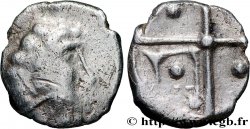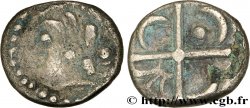v29_0654 - GALLIA - SOUTH WESTERN GAUL - LONGOSTALETES (Area of Narbonne) Drachme “au style languedocien”, S. 292
MONNAIES 29 (2007)
Starting price : 600.00 €
Estimate : 900.00 €
Realised price : 600.00 €
Number of bids : 1
Maximum bid : 600.00 €
Starting price : 600.00 €
Estimate : 900.00 €
Realised price : 600.00 €
Number of bids : 1
Maximum bid : 600.00 €
Type : Drachme “au style languedocien”, S. 292
Date: IIe siècle av. J.-C
Metal : silver
Diameter : 16 mm
Orientation dies : 4 h.
Weight : 3,47 g.
Rarity : R3
Coments on the condition:
Monnaie frappée sur un flan arrondi et régulier. Droit légèrement décentré, mais néanmoins presque complet et de frappe très vigoureuse. Revers légèrement décentré sur la gauche mais complet. Fine patine grise un peu hétérogène
Predigree :
Cette monnaie provient de la collection de G. Savès
Obverse
Obverse legend : ANÉPIGRAPHE.
Obverse description : Tête à gauche avec la chevelure à grosses mèches et tresses descendantes à plusieurs brins attachés en bas ; sourcil épais ; cou orné d'un collier de perles ; deux dauphins stylisés devant la bouche.
Reverse
Reverse legend : ANÉPIGRAPHE.
Reverse description : Croix bouletée au centre, formée de quatre cantons, chacun ornés d’une lunule ; une abeille stylisée en quatre points au 1er canton, une oreille au 2e, une hache à gauche au 3e et un œil de face au 4e.
Commentary
Comme pour la drachme à quatre cantons sans symbole de MONNAIES XXIII, n° 734, ce type est "à rapprocher du type "cubiste" romanisé par son droit. En revanche, cet exemplaire a un symbole dans chacun des cantons de la croix. Ce type s'apparente à la série 63 (du Moneta 28) pour laquelle les exemplaires recensés sont listés dans la série 61 !.








 Report a mistake
Report a mistake Print the page
Print the page Share my selection
Share my selection Ask a question
Ask a question Consign / sell
Consign / sell
 Full data
Full data



